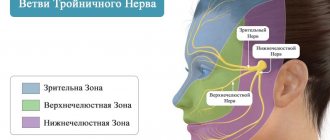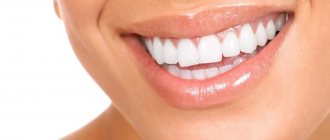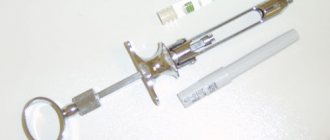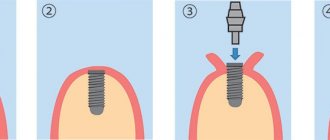antiseptics in dentistry
| Definition Antiseptics and disinfectants refer to antimicrobial agents that lack selectivity of antimicrobial action (they are active against most microorganisms, protozoa and fungi and do not cause the development of resistance). Antiseptics are used to destroy pathogens located on the surface of human tissue. They are applied to the skin and mucous membranes (including the gastrointestinal tract and urinary tract); in dentistry they are used to treat pathological periodontal pockets with periodontal disease, root canals and tooth cavities. The mechanism of action of most antiseptics is associated with their ability to denature proteins (structural and enzymatic) and thus have a bactericidal effect. Due to the lack of selectivity, antiseptics are organotropic in relation to the macroorganism). Classification and main representatives Antiseptics and disinfectants are classified according to their chemical structure: I. Halogen-containing compounds (derivatives of chlorine, iodine, etc.). Antiseptics of this group have a pronounced bactericidal, sporicidal, fungicidal and deodorizing effect. The most active drugs are those containing elemental halogens or releasing them (bleach solution, chloramine B, alcoholic iodine solution, Lugol's solution, iodinol, iodocam, iodoform, pantocid). II. Oxidizing agents (potassium permanganate, hydrogen peroxide solution, hydroperite). The principle of action of drugs in this group is the release of oxygen and oxidation of organic components of the protoplasm of microorganisms. They have a deodorizing effect. A solution of hydrogen peroxide helps to mechanically cleanse the wound and stop bleeding. III. Antiseptics of the phenol group (pure phenol, resorcinol, tricresol, ferozol, resorcinol, benzonaphthol, vagotil). Phenol has bactericidal, sporicidal and fungicidal effects. Irritates tissue, is easily absorbed from the site of application, toxic. It is used as an antiseptic in dentistry during root canal treatment and necrotization of the dental pulp. Vagotil has a local bactericidal and trichomonacid effect. Resorcinol is inferior to phenol as an antiseptic. In small concentrations it has a keratoplastic effect, and in large concentrations it has a keratolytic and cauterizing effect. The phenol group also includes eugenol (allylguaiacol), which is the main component of clove oil and has a disinfectant and local anesthetic effect. IV. Aliphatic antiseptics from the group of alcohols and aldehydes (formaldehyde solution, hexamethylenetetramine (methenamine), ethyl alcohol, beta-1-lysoform, cyminal). Formaldehyde preparations have antimicrobial, sporicidal, deodorizing, dehydrating and mummifying properties. They are used to treat skin during sweating, and in dentistry for necrotization and mummification of dental pulp. The antimicrobial activity of ethyl alcohol increases with increasing its concentration. It does not affect disputes. |
| Disinfectants for medical, children's and veterinary institutions.septustin.ru |
In dentistry, this group of drugs is used very widely. Antiseptics are used to treat the surface or cavities of the human body, disinfectants are used to treat external objects, instruments, impressions, dentures and their semi-finished products or patient secretions. The spectrum of action of antiseptics and disinfectants is wide and extends to bacteria, fungi, protozoa and some viruses. The mechanism of action may be associated with protein denaturation, disruption of the permeability of the plasma membrane, and inhibition of the activity of microbial enzymes. Halogen-containing antiseptics include iodine and chlorine preparations. In dentistry, iodine preparations (an alcohol solution of iodine with the addition of tannin and glycerin, potassium iodide, iodinol, iodoform, etc.) are used to treat the mucous membrane, treat and diagnose gum diseases, arthrosis of the temporomandibular joint, etc. Preparations containing iodine can cause irritation mucous membrane and allergization upon repeated use. The irritating effect is minimized with iodine preparations on an organic carrier (iodinol, povidone iodine). A highly effective antiseptic and disinfectant is a dichlorine-containing biguanide derivative - chlorhexidine, which has bicationic properties, does not have a damaging effect on tissues and is used in dentistry both as an independent drug (solution) and in the form of various combined dosage forms (rinses, toothpastes for therapeutic and prophylactic purposes , tablets for resorption in the oral cavity, etc.) for the treatment of ulcerative stomatitis, gingivitis, and the prevention of caries. From the group of oxidizing agents, hydrogen peroxide and potassium permanganate are used, which have an antiseptic, deodorizing and hemostatic effect due to the release of oxygen. From the group of aldehydes, formaldehyde (preparation of a resorcinol-formalin mixture for filling root canals, a disinfectant) and paraform (pastes for pulp devitalization) are used in dental practice. Formaldehyde has bactericidal, virucidal, funcidal and sporicidal effects. The acids are represented by boric acid and sodium tetraborate, which have a pronounced antimicrobial and antifungal effect (treatment of stomatitis, especially candidiasis). Among metal salts, silver nitrate is widely used (impregnation of difficult-to-pass channels). An extensive group of drugs in dentistry consists of phenols, which have diverse effects, including: local anesthetic, cauterizing and necrotizing (phenol or carbolic acid, vagotil), keratolytic and keratoplastic (resorcinol), astringent and deodorizing (thymol, biclotymol) effects. Phenol has the greatest potential toxicity in this series.
Dyes are represented by brilliant green, methylene blue and ethacridine lactate (treatment of skin and oral mucosa). Detergents (dimexide, miramistin) are used to treat periodontal diseases and oral mucosa, to prevent suppuration and purulent wounds. Ethyl and isoprylic alcohols (at a concentration of 60-90% by volume), which are used for disinfection, have bactericidal and virucidal properties.
| BETADINE Antiseptic drug. Solution for local and external use |
| HEXICON Antiseptic drug for external and local use. Gel for local and external use. Solution for external use |
| HEXORAL Antiseptic drug for topical use in ENT practice and dentistry. Aerosol for topical use 0.2%. Solution for topical use 0.1% |
| YOX A drug with antimicrobial and anti-inflammatory effects for local use in ENT practice. Solution for topical use. Topical spray |
| METROGYL DENTA For the treatment and prevention of infectious and inflammatory diseases of the oral cavity. Dental gel |
| SEPTOLETE NEO Antiseptic for topical use in ENT practice and dentistry. Pastilles |
| ELIGEL Antiseptic for local use in dentistry. Gel for gums |
When carrying out preventive measures, it is necessary to use antimicrobial drugs that affect both anaerobic and aerobic microflora. One of the most universally effective antiseptics is a biguanide derivative - chlorhexidine.
It is part of many therapeutic and prophylactic products, including toothpastes. Chlorhexidine causes a pronounced effect on gram-positive and gram-negative bacteria, fungi, facultative aerobes and anaerobes, herpes viruses, reducing the number of microorganisms in saliva that stimulate the formation of dental plaque by 80-90%.
The effect of chlorhexidine in relation to microorganisms is explained by the interaction between the positively charged molecule of the drug and negatively charged groups of molecules in the bacterial cell wall, which facilitates the penetration of the active component into the cytoplasm of the microorganism and its destruction.
Chlorhexidine is selectively adsorbed on the surface of hydroxyapatite tooth enamel, thereby preventing the adsorption of bacteria. In addition, binding to the protein structures of oral tissues causes a prolonged effect due to its gradual release. In addition to being bactericidal, chlorhexidine has a weak analgesic property. Long-term use of pastes with 2.2-0.4% chlorhexidine can lead to increased formation of tartar and oral dysbacteriosis.
These side effects are reduced in some formulations by the addition of chelating agents.
Recently, triclosan, a phenol with a broad antimicrobial effect, has been widely used. Effective against yeast fungi, gram-positive and gram-negative microorganisms, has a bacteriostatic or bactericidal effect due to the effect on the cytoplasmic membranes of bacteria, depending on the concentration. Compatible with other components of hygiene products, does not cause the formation of resistant microbial strains. As already indicated, along with the positive effect, the listed drugs can also have side effects on the tissues of the oral cavity, therefore their use as prophylactic agents should be monitored by specialists.
Antiseptic agents (most often chlorine-, phenol- or triclosan-containing) are included in such therapeutic and prophylactic pastes as Lacalut, Colgate, President, Aquafresh. Histerine, etc. In addition, these components, in various versions and in combination with herbal additives and fragrances, are also included in rinses.
"Elgidium" is an antibacterial toothpaste containing chlorhexidine digluconate and calcium carbonate. The effect of chlorhexidine is described above. Calcium helps reduce gum bleeding, neutralizes oral fluid when it becomes acidic and enhances the effect of chlorhexidine. The therapeutic effect of one cleansing with Elgidium lasts 24 hours, which is a clear advantage of this product.
One of the predisposing factors for the occurrence of an inflammatory reaction in the periodontium, with the same strength of the damaging effect of microflora, is a decrease in the effectiveness of antioxidant protection of tissues under the influence of various pathogenic influences of a general nature: stress, somatic diseases. Therefore, the use of correction of the relationship between the pro-oxidant and antioxidant systems of periodontal structures with the help of antioxidants is a pathogenetically justified effect.
From this point of view, Mexidol toothpaste (TK Pharmasoft LLC) deserves attention, containing the drug Mexidol, as well as a 5% Mexidol solution for rinsing. Of unconditional interest are the President line preparations, both pastes and rinses, the preventive effect of which is also due to their antioxidant effect due to plant extracts and, of course, the specific effect of triclosan.
President Active is a paste with controlled abrasiveness RDA 75. It contains: zinc citrate 0.75%; triclosan 0.35%; extracts of sanguinaria, hawthorn; sodium fluoride 0.32%. President Exclusive paste, which contains hexitidine 0.1%; thyme extract, propolis; monofluorophosphate 0.8%, sodium fluoride 0.1%. The mechanism of preventive action of Colgate pastes is similar: Colgate Propolis, containing propolis; "Colgate Medicinal Herbs", which includes a number of plant extracts: eucalyptus, tea tree, sage, myrrh and chamomile.
Source: https://meduniver.com/Medical/stomatologia/649.html MedUniver
Your login:
58cd01520f4b
Your password:
0e2bd534495b
Due to the widespread prevalence of pulp and periodontal diseases, endodontic treatment is of particular importance in modern dentistry [6, 8]. Endodontics deals with the treatment and prevention of caries complications. The modern level of dentistry has a number of features and is characterized by the emergence of new technologies, modern equipment and materials.
The prevalence of dental caries and its complications among the adult population of Russia is quite high - according to the literature, it ranges from 90 to 100% [11] in people under 44 years of age; Pulpitis and periodontitis account for at least 45-50% of all dental diseases, and the inflammatory process in the periodontium in people over 50 years of age is the cause of tooth extraction in more than 50% of cases. In recent years, some progress has been made in the treatment of complications of caries (pulpitis and periodontitis), but this problem continues to remain far from a final solution. The lack of effectiveness of periodontitis treatment determines the task of finding new ways to solve this urgent problem and necessitates the development of new approaches to complex therapy [5, 9, 10].
The success of treatment of pulpitis and periodontitis largely depends on the effectiveness of the impact on the microbial factor. The main condition for successful endodontic treatment is thorough mechanical and medicinal treatment of the carious cavity and root canal, which involves the complete elimination of bacteria and their toxins [4].
Poor treatment of periodontitis is the cause of the development of the inflammatory process in at least 65% of patients with periostitis of the jaws, in 75% of patients with osteomyelitis, in 69% of patients with phlegmon of the maxillofacial area.
Literature data indicate the unsatisfactory quality of endodontic treatment at a general dental appointment: the depth of filling in only 54% of the teeth studied was optimal, in 32% of cases the filling was incomplete, in 14% of cases there was excessive removal of filling material into the periodontium. Complete closure of the root canal system with a biocompatible material, ensuring conditions of impermeability to bacteria is the main guarantee of stopping antigenic stimulation of periodontal tissues, creating favorable conditions for reparative processes in the periapical zone and preventing re-infection in the long term after completion of treatment [1, 3, 6].
The purpose of this study is to study the antimicrobial activity of antiseptic drugs used in endodontics for root canal treatment.
Material and methods
The study used a solution of chlorhexidine bigluconate in 6 concentrations (2.0; 1.0; 0.5; 0.2; 0.1; 0.02%), 2 drugs based on sodium hypochlorite - Parcan (France) and Hypochloran -3 (Russia), as well as a stabilized solution EDTA “Solutions” (Korea).
Working solutions of chlorhexidine were prepared by diluting a 20% solution. Parcan, Hypochloran-3 and EDTA “Solutions” were used in finished form.
Sample preparation and testing were carried out under aseptic conditions.
To determine antimicrobial activity, control strains of microorganisms were used: Escherichia coli, Staphylococcus aureus, Candida albikans, Staphylococcus faecalis
. The cultures were grown at a temperature of -37 °C for 24 hours. For testing, they were diluted 1:1000 with a sterile 0.9% sodium chloride solution.
1 ml of a suspension of the test strain was added to the agar surface of the nutrient medium. The cups were dried and holes with a diameter of 10 mm were made with a special punch. The test solution was added to the wells. The results were recorded after 24 hours, measuring the zone of growth inhibition around the well.
Results and discussion
Chlorhexidine is an antiseptic agent active against vegetative forms of gram-positive and gram-negative microorganisms, fungi of the genus Candida
, lipophilic viruses, Staphylococcus aureus, periodontopathogenic microorganisms. Depending on the concentration used, it exhibits a bacteriostatic or bactericidal effect. Can be used in different concentrations from 0.01 to 5% aqueous and alcohol solutions.
This antiseptic is quite widely used in medicine in general and dentistry in particular [3]. The action of chlorhexidine is based on the ability to be in prolonged contact with negatively charged bacteria (it itself has a strongly positive charge), which leads to rupture of the cell membrane, which, under the influence of chlorhexidine, is unable to maintain osmotic balance.
Chlorhexidine is widely used in endodontics for root canal treatment. However, there is evidence that dentin and dentin components, including collagen, significantly reduce, even completely inhibit, its antimicrobial effect [12].
The results of determining the antimicrobial effect of chlorhexidine are presented in table. 1.
They indicate that the level of antimicrobial activity of chlorhexidine is directly proportional to its concentration: with its decrease, the zone of inhibition of the growth of microorganisms decreases. The highest activity of all tested chlorhexidine solutions against E. coli
, least - to
St.
faecalis .
Slight differences in the antimicrobial effects of 0.2 and 0.1% chlorhexidine solutions were noted. When exposed to St. aureus
and
E. coli
growth inhibition zone was 28.0 and 30.0 mm, respectively. Despite the fact that the concentrations of the studied solutions differed by 100 times (2.0% and 0.02% solutions), their activity against all studied strains remained at a fairly high level even at a concentration of 0.02%.
Sodium hypochlorite (NaOCl) is the sodium salt of hypochlorous acid, contains 95.2% active chlorine, a very strong oxidizing agent. It has an antiseptic and disinfectant effect [2, 7]. NaOCl - exhibits its activity due to the chlorite ion. NaOCl kills microorganisms quickly and in low concentrations. Shows the highest activity in a neutral environment. The decomposition of NaOCl is accompanied by the formation of a number of active species and, in particular, singlet oxygen, which has a significant biocidal effect. Some human cells, in particular neutrophils, hepatocytes, etc., synthesize hypochlorous acid and accompanying highly active radicals to fight microorganisms and foreign substances. NaOCl has a pronounced effect on gram-positive and gram-negative microorganisms, fungi of the genus Candida
, periodontopathogenic microorganisms, also has antiviral properties, including against HIV, rotaviruses, herpes viruses and hepatitis A and B. The most resistant to the action of sodium hypochlorite are enterococci, especially
St.
faecalis .
Sodium hypochlorite is widely used in endodontics as an antiseptic and irrigant solution.
The results of determining the spectrum of antimicrobial activity of drugs based on sodium hypochlorite are presented in table. 2.
Studies have confirmed the high level of antimicrobial activity of sodium hypochlorite, which is higher than that of chlorhexidine. For example, in relation to Staphylococcus aureus, Hypochloran-3 is almost 1.5 times more active (growth inhibition zone is 38.0 and 52.5 mm, respectively).
The strongest antimicrobial effect of Parcan against E. coli
(45.0 mm), the smallest in relation to
St.
faecalis (33.5 mm).
Hypochloran-3 is most active against St.
аureus .
Effect on the St.
faecalis was slightly more pronounced in Parcan than in Parcan.
The data obtained during the study are comparable with literature data, especially regarding the effect of hypochlorite on the St.
faecalis .
EDTA Solutions is the disodium salt of ethylenediaminetetraacetic acid. It is used in dentistry to widen root canals. EDTA is capable of forming complex compounds with various positively charged ions. Data from studies of the antimicrobial effect of EDTA are presented in table. 3.
The preparation for treating root canals for the purpose of their expansion, EDTA “Solutions,” has pronounced antimicrobial activity against all tested strains. The greatest zone of growth retardation was identified when exposed to St. faecalis
(48 mm).
The results of the study confirmed the high antimicrobial activity of chlorhexidine antiseptics and preparations based on sodium hypochlorite. The mechanism of the bactericidal action of EDTA was not studied in this study, but the drug can be successfully used not only to expand the root canals of teeth, but also as an antiseptic.










